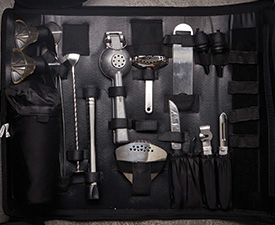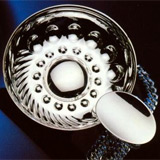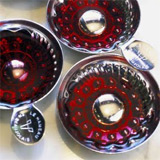A Tastevin is a small, very shallow silver cup or saucer traditionally used by winemakers and sommeliers when judging the maturity, quality and taste of a wine.
The saucer-like cups were originally created by Burgundian winemakers (where a very high-level wine society called the Confrerie des Chevaliers du Tastevin, was named after the tasting cup) to enable them to judge the clarity and colour of wine that was stored in dim, candle-lit wine cellars. The Tastevin cup can vary in size but is typically 7-8 cm in diameter.
The wine would be poured into a shallow layer over the brightly reflecting silver, tasted and swirled by the connoisseur and spat out into a bowl. By definition a taster, "tasse a vin" or tastevin would only hold a small amount of the wine. It needed to be made of a material strong enough to withstand the rigors of daily use as well as being made of a material (Sterling silver) that would not taint the wine in any way.
Regular wine glasses were too deep to allow for accurate judging of the wine's colour in such faint light. Since it is flat like a saucer, it is almost useless for smelling the wine. Tastevin are designed with a shiny faceted inner surface. Often, the bottom of the cup is convex in shape. The facets, convex bottom, and the shiny inner surface catch as much available light as possible, reflecting it throughout the wine in the cup at various angles at once, making it possible to see through the wine. Clarity is less of an issue than it used to be in wine, and with the advent of modern electric lights, glasses are much more effective, so the tastevin has mostly been relegated to novelty.
Although Sommeliers often wear them around on a ribbon or chain around the neck as a sign of respect to tradition.
There are references to the use of Tastevin's in old manuscripts of the 14th and 15th centuries and the earliest English tastevin is dated 1603. The tastevin remains today as the acknowledged ceremonial symbol of Burgundy, France.











